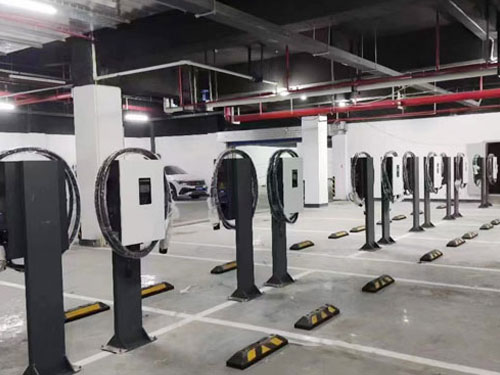-
 +86 18924678741
+86 18924678741 -
 sales@hjlcharger.com
sales@hjlcharger.com -
 Shenzhen City, Guangdong Province, China
Shenzhen City, Guangdong Province, China
The installation of an electric vehicle charging station is a complex process involving multiple steps and links, which requires careful planning and preparation. The following is a detailed guide to installing an electric vehicle charging station:
I. Preparation stage
Understand policies and regulations:
Learn in advance the policies, regulations and conditions for the installation of electric vehicle charging stations in your area, including parking space requirements, power supply requirements, approval process, subsidy policies, etc.
Consult local power companies, government departments or relevant agencies to ensure that the installation process complies with local laws, regulations and standards.
Prepare necessary materials:
Owner's identity certificate (ID card, driver's license, etc.).
Proof of vehicle purchase (purchase invoice, driving license, etc.).
Parking space certificate (parking space property certificate, lease contract, etc.). If installed in a community or public parking lot, a consent letter from the property or owner's committee is also required.
Power company application form and other relevant documents.

II. Site selection planning
Determine the installation location:
Choose a suitable installation location, which should be close to the parking space or parking lot for convenient charging operations.
Ensure that the power supply at the location is sufficient and meets the installation requirements of the charging station.
Evaluate whether the surrounding environment is suitable for installation, including the size of the parking space, the location of the power access point, the length and path of the power line, ventilation conditions, and whether there are flammable and explosive items.
Apply for power capacity increase or new installation:
If the existing power capacity is not enough to support the operation of the charging station, you need to submit an application to the power company to increase the power capacity or install a new power socket.

3. Purchase charging equipment
Choose the right charging equipment:
Choose the right charging equipment according to the model of the electric vehicle and the charging needs. There are two main types of AC charging piles and DC fast charging piles on the market. AC charging piles are mainly used in home and commercial scenarios, while DC fast charging piles are suitable for long-distance travel or when you need to replenish power quickly.
Make sure that the selected equipment supports the charging voltage and current of your own electric vehicle and complies with local safety standards and regulations.

4. Installation and construction
Install the power line:
Ask a professional electrician to lay the power line according to the specifications and requirements of the charging equipment and lead the power to the selected installation location.
In this process, some civil engineering works may be required, such as trenching and burying cables.
Install the charging equipment:
Install the charging equipment in a suitable location and connect the power cord and ground wire.
Ensure that all connections are secure and meet electrical safety standards.
Set up the control panel:
Set up the control panel of the charging device, such as setting parameters such as charging time and charging current.
V. Testing and Acceptance
Perform the test:
Turn on the power and test whether the charging device is working properly.
Check whether the charging interface and power cord are connected correctly and whether the charging status display is normal.
Acceptance and filing:
If everything is normal, conduct acceptance and fill in the relevant acceptance report and form.
Submit the relevant information of the charging device to the property or parking lot management department for filing.
At the same time, inform the power company of the acceptance results and filing information so that it can update the power grid information and provide follow-up services.

VI. Post-maintenance
Regular inspection and maintenance:
Regularly check whether the power line, charging interface, display screen and other components of the charging device are intact.
Check whether the grounding protection of the charging device is good, and clean up the debris and dust around the charging device.
It is recommended to conduct a comprehensive inspection and maintenance every quarter or every six months.
Software upgrade:
Pay attention to the software update information of the charging device and perform software upgrades in time to maintain the advancement and stability of the system.
By following the above steps and precautions, you can successfully complete the installation of the electric vehicle charging station and enjoy convenient charging services. At the same time, during the entire installation process, you need to maintain smooth communication with the power company, property or owner's committee, installation company or professional electrician to ensure that all materials and equipment meet relevant standards and regulations and comply with electrical safety regulations and operating procedures.
If you want to know more about "ev charging station installation", you can consult us online or email (sales@hjlcharger.com).
The New Year's Day of 2024
A successful conclusion!Looking forward to the nex...
According to the spirit of the "Notice of the...
Ev charging station factory Ho
The selection of the best ev c
Public electric car charging i
what is inside an ev charger?E
How much is a charger for an electric car? The pri...
The working principle of elect
Find and compare the best ev charger by
5 meters new energy electric vehicle cha
Product numberDCB015A-V2GDetailed specif
Hongjiali New Energy sells electric car
Whenever you need us, we're here for you. --- Contact us for all your support needs, from technology, general queries to information support, etc. Our hotline numbers and e-mail are open 24hx7d for your needs.

 +86 18924678741
+86 18924678741 sales@hjlcharger.com
sales@hjlcharger.com Shenzhen City, Guangdong Province, China
Shenzhen City, Guangdong Province, China